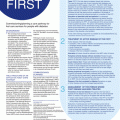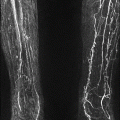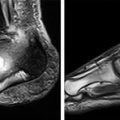Figure 14.1
Clear diabetic foot pathway as per NICE CG 10
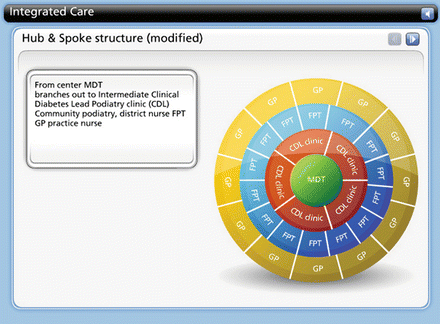
Figure 14.2
Hub and spoke structure of care
With scare resources, the MDT, using images from primary care, can use telemedicine to monitor and record the progress of patients. Based on these images, treatment plans can be formulated.
The intermediate clinic could be used to act as gatekeeper for patients with new ulceration and active diabetic foot disease, with seamless access to the hospital-based MDT if required (Fig. 14.3).
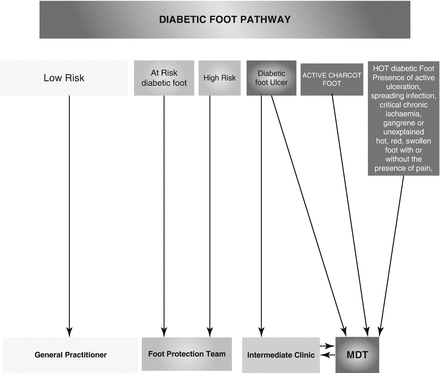

Figure 14.3
Practical integrated care pathway
Standardised Care
As part of the Quality Outcomes Framework (QOF), diabetic patients should have their feet examined for palpable pulses, evidence of peripheral arterial disease, skin changes, foot deformity, and the presence of an ulcerated foot at present or in the previous 15 months. Their feet should be tested with 10-g monofilaments or tuning forks (128 Hz) to assess for peripheral neuropathy [4].
Patients should then be placed into the appropriate risk classification:
Low risk – normal sensation, palpable pulses
Increased risk – neuropathy or absent pulses
High risk – neuropathy or absent pulses plus deformity, or skin changes or previous ulcer (within the previous 15 months)
Ulcerated foot/Active foot disease
It is important to ascertain who has carried out this assessment and to what standard. The assessment needs to documented in the patient’s records so that it is immediately apparent to any health-care professional treating the patient.
One solution to help standardise diabetic foot assessment and screening would be an e-learning programme, similar to the one used by the Foot Risk Awareness and Management Education (FRAME) project set up by the Scottish Government and Edinburgh University [5]. This could provide some clinical governance and ensure that the same standard of assessment is used by all health-care professionals.
The Society of Chiropodists and Podiatrists, together with the Scottish foot action group, have produced a range of competencies for the delivery of diabetic foot care across the diabetic foot risk spectrum. These competencies could be used by all who provide care for diabetic foot patients [6]. This would give patients the assurance that they will be treated by a clinician with competencies specific to the management of the diabetic foot, relative to their level of need, and reassure employers that their staff have the necessary skills required to safely treat patients in their care.
Preventative Diabetic Foot Care
Some diabetic foot ulceration is the result of an accidental injury that cannot be avoided, but in many cases, burning an insensitive foot on hot water bottles, on hot surfaces such as sand, or pavements in hot countries whilst on holiday, or walking barefoot and sustaining injury can be avoided by increasing awareness of these risks with education. The importance of checking for foreign objects in shoes, avoiding badly fitting shoes that rub and cause blisters and ulceration are preventative actions that can be re-enforced to the patient. Here education may prove helpful if the patient understands the advice and is empowered to help themselves.
The development of ulceration at high pressure areas from deformity resulting in callus formation can be averted by regular podiatry, offloading the foot from the ground and from the shoe.
The provision of specialist footwear must be a multidisciplinary decision, to include the patient, podiatrist and orthotist and should be timely, with patient follow-up and review after any footwear or orthoses are issued and any problems rectified. Ill-fitting specialist footwear results in a waste of resources and a loss of confidence by patients in the whole process.
Stay updated, free articles. Join our Telegram channel

Full access? Get Clinical Tree



